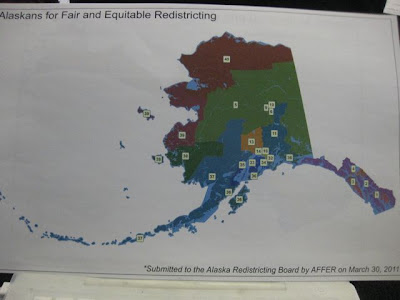There are more details and explanation at the
Alaskans for Fair and Equitable Redistricting website including high resolution maps.
[UPDATE 9:26pm: I just want to say that is is confusing. It's my understanding that Alaskans for Fair Redistricting has been around since at least the last redistricting process (ten years ago.) But now it seems that there is a new group (not sure when they got set up) that calls itself Alaskans for Fair and Equitable Redistricting. Randy Ruedrich - the head of the Republican Party in Alaska - is associated with Fair AND EQUITABLE, while Fair Redistricting is a collaboration of Labor and Alaska Native organizations.]
12:38pm Carl Marrs, Vince Beltrami, and Joe McKinnon are testifying. Again, I've . . .

Marrs: We do not pair incumbents if possible. Except for SE Alaska, no incumbents are paired. Preserves core of those preserving districts, maintinga urban neighborhoods. Continuing existing relationships with existing officials allows . . .
They are passing out maps.
Attorney asked about the apparent loss of one Native district (from 8 to 7) and whether that is retrogression. REsponse: Unavoidable retrogression.
Solve Juneau problems by going to north to Skagway and Haines and Gustavus. Forces doubling incumbents. Driven by voting rights act. In Ketchikan, we take Wrangell, because a predominantly non-Native district.
Attorney White: Is your plan basically Juneau's north Juneau plan?
Maybe, we leave Saxman in with Ketchikan and same with Klukwan, though they both have strong Native populations.
McConnochie: Where's the border between north and south Juneau?

McKinnon: Near the airport
Kodiak too small for district by itself. Tie it in with S coastal areas of PW Sound - Cordova, Seldovia, Port Graham, - surplus population on Kenai Pen. we can do that.
Because there are so many people in here, I can't easily run around to take pictures or get good shots of the slides they are showing.
White: 3.4% deviation - could you make those smaller not considering not pairing incumbents?
McKinnon: Even with pairing incumbents we could. But we tried to use main thoroughfares as natural boundaries. If we didn't do that, we could break out small neighborhoods and balance more.
 |
| (l-r) Marrs, McKinnon, Beltrami |
Kenai: main change move Cooper Landing and Moose Pass into 32. Tried to keep borders between 33 and 34 as close to current. A bit of 34 into 35 to make up for other changes in that area.
1:10pm they're done. Alaska Dem Party next.
















